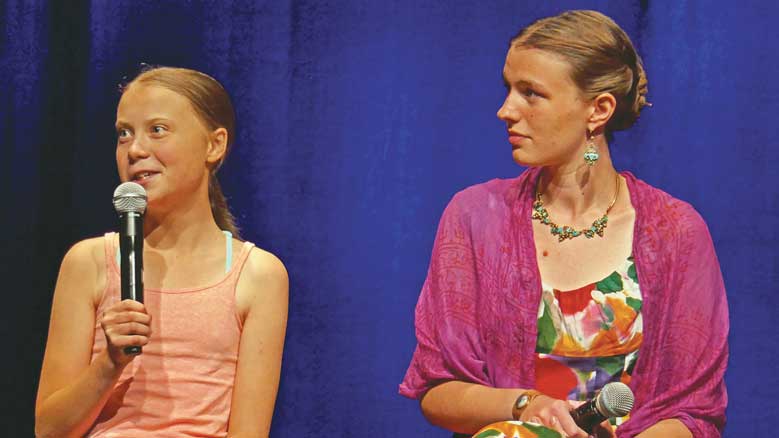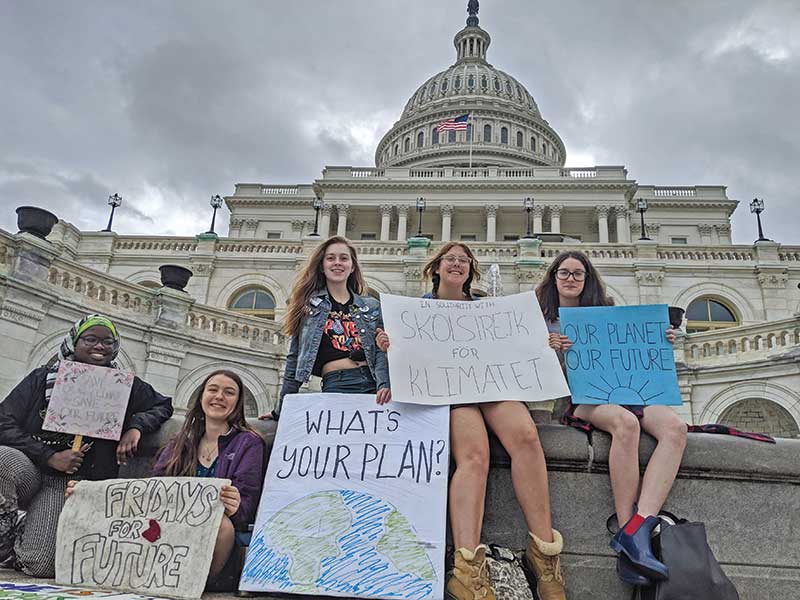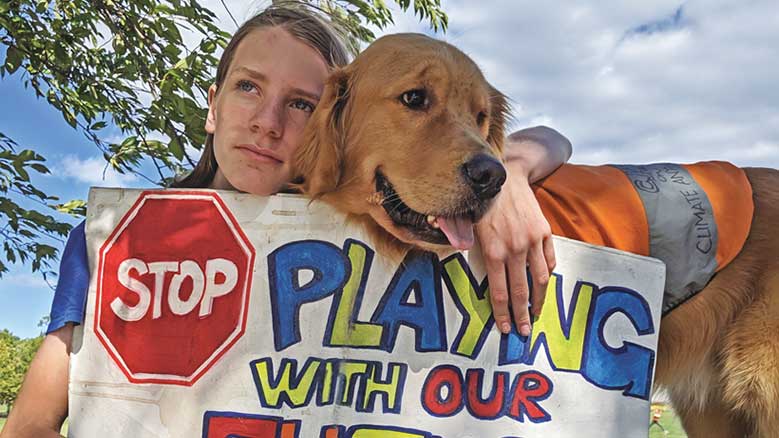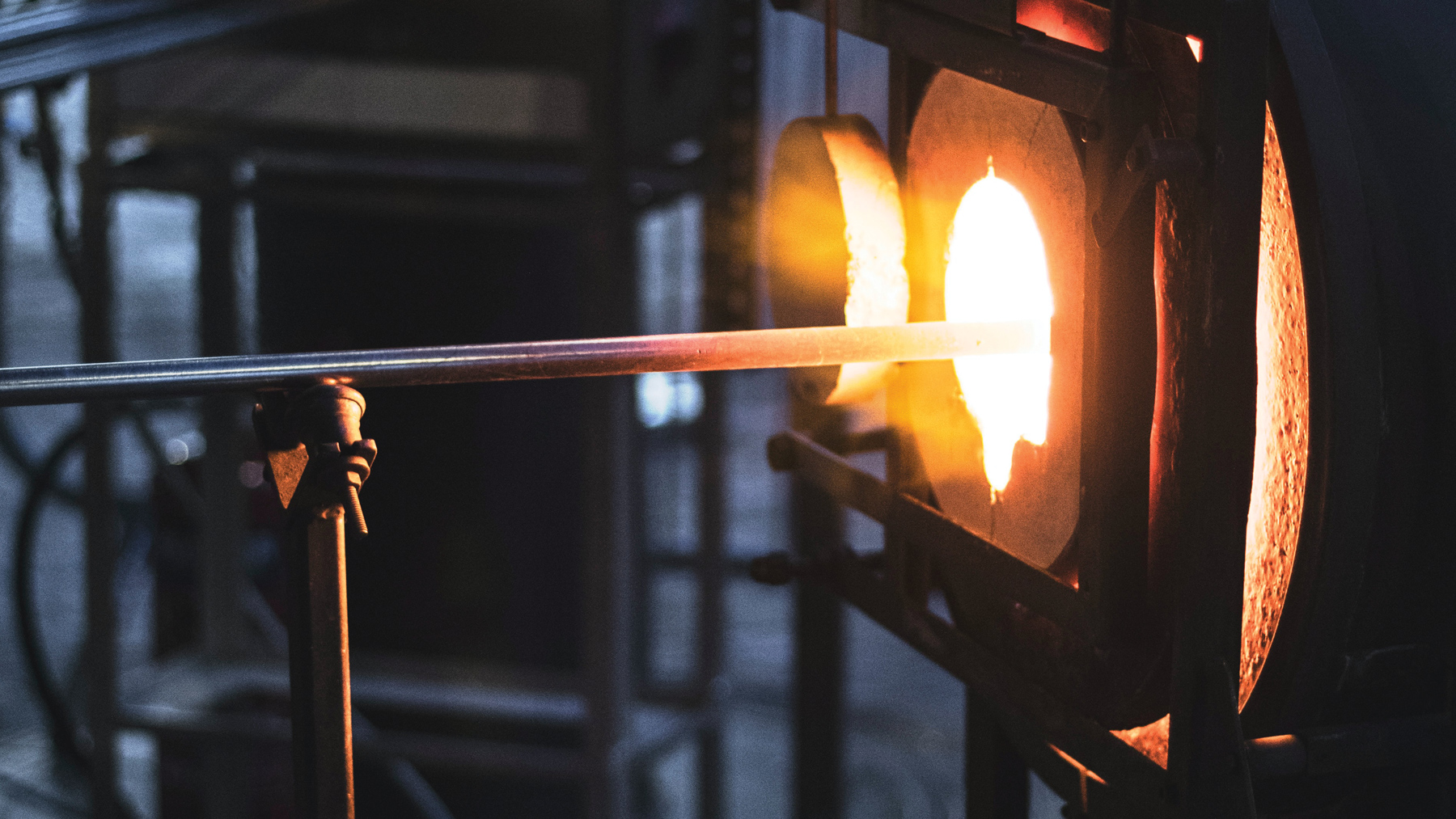
“We do not want to sacrifice our education. We do not want to sacrifice our childhoods. You have left us no choice. Our future is already being sacrificed by your inaction. We will not put down our signs and go back to school until you act to stop fossil fuel emissions. Giving up is not an option.” —Kallan Benson, September 2019 speech
Kallan Benson is a 15-year-old, third-generation Quaker and member of Annapolis (Md.) Meeting. She was representing the global community of Fridays for Future (FFF), the climate strike movement inspired by Greta Thunberg. The United Nations Environmental Program was recognizing FFF as “Champions of the Earth.” The September 26, 2019, award came on the heels of ceremonies ten days earlier honoring the FFF strikers globally with Amnesty International’s highest honor, the Ambassador of Conscience Award.
Kallan’s UN address began:
As climate strikers, we are a bit uncomfortable at this award ceremony. Awards are for celebrating achievement, but the achievement we seek has not occurred. The world is in climate crisis, and actions of the United Nations are failing to stop it.
Minutes later she concluded:
We understand the Champions of the Earth award is a great honor, but we cannot accept it. Instead, we offer to hold it for you to earn. You at the United Nations hold the power to save humanity from itself. You must act in time to become the real champions of the Earth. Then, we will all have an achievement worth celebrating far into the future. Every Friday, we invite all people of conscience to climate strike.
When I watch Kallan’s brief address and listen to the audience’s applause when she says, “Instead, we offer to hold it for you to earn,” I feel overwhelmed with admiration for the young climate strikers. I also feel guilty that my generation’s inaction has brought us to the brink of climate catastrophe. I’ve shared her speech on social media and have forwarded it to friends, acquaintances, and elected representatives. Her full address is on YouTube at fdsj.nl/kallan-speech.
The young climate strikers have invited us to join them in speaking to power to unite behind the science; create a pathway to keep warming below 1.5 degrees Celsius; and ensure a just, equitable transition off fossil fuels. Because the forces driving us toward climate breakdown are embedded in our lifestyles, they call for apolitical, systemic action.

Kallan’s Climate Striking Begins
Kallan registered as the first official U.S. FFF striker on December 7, 2018, four months after the August start of Greta’s Friday strikes outside Sweden’s Parliament. Around that same time, Greta began meeting with world leaders and obtaining significant resource commitments to reduce greenhouse emissions. A week after Kallan began striking, Greta told the UN’s Climate Change Conference (COP24) in Katowice, Poland, “You are stealing our future.” (This conference was where an agreement was sought on how greenhouse emissions would be counted and how the international community would verify that countries are taking steps to which they committed.) At first, Kallan struck in Washington, D.C., every Friday; in January, she began striking daily outside the Maryland General Assembly for the winter session’s duration.
As Kallan planned her winter strike, she confided with her family, “I have an idea, and when I tell you, you’ll think I’m crazy.” She said she wanted to do a silent strike for 90 days. As a Quaker, Kallan appreciates that silence isn’t empty and holds profound power. Kallan’s mother, Kimberly, says they didn’t tell Kallan the idea sounded crazy. Instead, they asked, “What does your silence mean to you?” Kallan said, “That adults aren’t listening so I’m not speaking.” They asked her, “What do you think others will say?” Kallan said, “They’ll probably think I’m crazy; but I hope my actions will speak louder than my words.” Her fa
mily suggested that, instead of committing herself to 90 days of silence and feeling the pressure to stick it out, she should consider it an experiment: try it; see how it feels; see how you react; see how others react to you. Asking what we can learn from people’s reaction to the silence made it an uncharted, intriguing experiment that Kallan could end at any time.
With the start of the Maryland General Assembly’s winter session, Kallan began her 90-day silent strike. Homeschooled, she could work the strike around her studies, and at least one of her main teachers—her parents—was always in the vicinity. Her brother, Reece, naturally silent, often kept her company. The family’s golden retriever, their unofficial “Climate Anxiety Therapy” (CAT) dog, Osage, helped keep everybody warm. Kallan crocheted to stay busy, making hats, a 45-foot-long scarf, and thousands of little butterflies. Reece, who often wore Osage like a scarf, helped break the ice and allowed people to approach. As people neared, Kallan’s waving and smiling drew them closer. Often she handed them a crocheted butterfly. Sometimes, she played the cello. At first, she looked to her parents to step in and answer questions that her silence couldn’t answer, but they told her, “That would defeat the purpose of the experiment.” Typically, they dropped her off but didn’t stay so close by that people expected them to serve as her mouthpiece.
The media got wind of Kallan’s silent strike. If there was an interview, they provided questions ahead of time, often asking Kallan’s parents what it was like to have their daughter engage in a silent strike. On April 9, Kallan’s silent strike ended. She tells me: “Sometimes, people wondered why I was doing this, but when they found out I’m a Quaker, they said, ‘Now I understand.’” Was it difficult? “It was difficult not talking when I practiced with my orchestra. I did talk a little with my family.” Then she adds: “When you’re not focusing on formulating what you’re about to say next, it improves your ability to listen to what people are saying.”
With the end of her 90-day silent strike, Kallan and her family shifted focus to the Washington, D.C. strike, feeling it was important to have a striker presence in the national capital. Although Kallan had assumed the national coordinator role, she stresses that FFF is a movement without formal titles, not an organization, and shuns any notions of hierarchy: “Fridays for Future is strictly flat.” Consistent with Kallan’s view, Greta typically introduces herself, “I’m Greta Thunberg, a climate activist, and part of Fridays for Future.”
Kallan’s Path of Quaker Activism
Kallan’s activism initially took form and flourished in the context of her Quaker meeting, family, and other Quaker connections.
Kimberly Benson says that when Kallan was five, they read a book about origami peace cranes before the International Day of Peace. Kallan wanted to hand out cranes. They folded 100 paper doves and went to a grocery store to hand them out. Placing them in a stranger’s hand, Kallan said, “Happy International Peace Day.”
In September 2014, at age ten, with a group of Quakers spanning eight decades in age, she and Reece, then nine, attended the first People’s Climate March in New York City. In the January–March 2019 issue of Quaker Earthcare Witness’ BeFriending Creation, Kallan wrote: “I was inspired by the size and positive energy of the crowd; the clever messages of the signs; the creative, powerful art; and even the friendly courtesy of the police. During that march, I evolved from concerned kid to a committed activist.”
After Maryland imposed a temporary moratorium on fracking in February 2017, Kallan joined a group of young Quakers in canvassing for a permanent fracking ban, which the state legislature approved the next month.
Before the second People’s Climate March in April 2017, Kallan created the outline of a monarch butterfly and an earth background on a 24-foot play parachute in order to help provide a voice for young people. She first took it to a young Friends gathering. Eventually, she took it to Friends meetings in Sandy Spring, Maryland; Washington, D.C.; and Langley Hill, Virginia. Over 1,600 young people signed and shared their concerns on that parachute.
In January 2018, Kallan’s giant monarch-and-earth parachute inspired the Mother Earth Project to initiate Parachutes for the Planet, with Kallan serving as co-director. Sidwell Friends School created one. Friends Meeting of Washington (D.C.) produced several. Parachutes decorated the National Mall in Washington, D.C., during the youth-led Zero Hour March on July 21, 2018, and the third People’s Climate March in San Francisco on September 8, 2018. As of late-October 2019, 2,367 have been created in 42 states and 67 countries on six continents; the goal is to make 3,000.
In the month before becoming the first registered U.S. striker, Kallan shared her activism on a panel at the Parliament of World Religions and the Wild Center’s Annual Youth Climate Action Summit.
After Kallan’s silent strike ended, she could engage fully in international conference calls of the global FFF leadership. Until then she couldn’t actually speak! The movement was building momentum, and Kallan had developed important relationships with strikers. These were the leaders of other youth-focused organizations involved in climate change, along with FFF country-coordinators around the world. Though perceived internationally as “the person who coordinates the United States,” she prefers to call herself “a striker” or “a climate activist.” Says her mother, “When teens rebel against the status quo, it’s usually against their parents and their belief system and expectations for their futures. Kallan’s rebellion is against a bigger status quo, against a business-as-usual approach integral to society.”
There are two types of strikes: “weekly” and “global.” The weekly strikes involve fewer locations and people but provide relentless pressure. That’s where the slow erosion happens, like waves crashing repeatedly against rocks. The global strikes are an effort to coordinate momentum around the world. They involve more locations and people, draw more media attention, and attract fence-sitters. They are also the main entryway through which people become weekly strikers. Within the United States, global strikes require Kallan’s skills in negotiating with various U.S. partner organizations over national demands beyond the international FFF demands. Global strikes took place in March and May 2019, with two strikes in September bookending the UN Climate Action Summit. The next global strike will take place on November 29 or December 6, depending on country (December 6 in the United States).
Kallan has spoken about climate activism to youth and adults at various meetings; brought projects to Quaker schools; and spoken at Baltimore Yearly and Interim Meetings, the Pendle Hill retreat center in Pennsylvania, and other settings. She says she has yet to meet Quaker youths who resonate with what she’s doing and are ready to throw themselves into climate activism. Kimberly Benson says Quaker schools appear reticent to get heavily involved, “perhaps because they’re focused on getting their students into the best colleges and don’t wish to encourage disruption.” She adds, “I wish there was a way to find other Quaker youth involved in climate activism.”
Climate Activism in the United Kingdom
In late June, thousands of concerned UK citizens, including over 100 Quakers, traveled to Westminster for London’s the Time Is Now mass lobby to march, meet with politicians, and demand the government take action against climate breakdown. That same day, representatives of faith groups led a Walk of Witness down Downing Street, to an event at Church House (the central offices of the Church of England). There, alongside Jewish, Muslim, Buddhist, and Christian religious leaders, including former Archbishop of Canterbury Rowan Williams, 17-year-old Quaker Anya Nanning Ramamurthy spoke. A third-generation Quaker, member of London’s Tottenham Meeting, and climate striker, Anya had been selected to represent British Quakers. These were among her observations:
Quakers have a long-time commitment to peace. Climate justice has become central to our peace work and concerns as we believe that climate breakdown will fan the flames of war and injustice. A vision of climate justice is . . . about recognizing that our climate crisis is rooted in inequality: for hundreds of years, our global economy has been a place where a few have been winning whilst others have been losing out.
To confront the injustice of climate breakdown, we need to be active. We need to voice our views loud and clear, engage politically, and hold our leaders to account. We must build the world as we want to see it. God is within every one of us, and therefore we must act like it.
Anya’s full address is on YouTube at fdsj.nl/anya-speech.
Anya says she’s been aware we face climate crisis all her life. Since she was little, she participated in climate marches and rallies. Her family tries to reduce its carbon footprint by being vegetarian, not owning a car, buying secondhand, and sourcing produce locally. However, she says, personal choices won’t be enough to prevent the destruction of our common home. She began striking in February’s UK-wide student strike. “Many young Quakers are climate strikers,” she says. “And some are involved with organizing strikes and other actions as a part of the UK Student Climate Network (UKSCN) or the Scottish Youth Climate Strikers [SYCS].”
She explains that UKSCN calls and coordinates monthly strikes in England, Wales, and Northern Ireland, whereas SYCS plays a similar role in Scotland. In addition, UKSCN presses forward a national agenda, which includes getting the government to declare a climate emergency (which it did); and advocating for reform of the educational system to “teach the future.” They wish to revamp the educational system “to teach young people about the urgency, severity and scientific basis of the climate emergency and ecological crisis.” To involve people who may be less inclined to strike, “we’ve also recently held candle-lit vigils, where there’s time for silence, song, and prayer. People of all ages and faiths, and none, are welcome.”
There’s also extensive outreach.
We go into schools, meet with faith and community groups, and reach out to media, politicians and labor unions. We’re trying to increase awareness, gain support for student strikes, seek advice, and invite striking side-by-side the student strikers. We’ve even gone to festivals and music concerts to reach young people who are less involved with or aware of the movement.
Before the September global strike, Quakers in Britain issued a statement of support:
We are facing climate breakdown. Quakers in Britain uphold those taking part in and supporting the Global Climate Strikes. . . . To confront our climate crisis we must question business as usual. We thank the youth strikers for their leadership for this day of action.
Although the movement made minimal effort globally to enlist adult strikers prior to September, it strongly encouraged their involvement in the September global strikes. Anya says, “For the September global strike in Britain, unions mobilized and faith groups and community groups encouraged members to strike with us in solidarity.”
What We Can Do
“A Shared Quaker Statement: Facing the Challenge of Climate Change,” a New England Yearly Meeting minute on climate change, should inform any actions Quakers might consider taking.
To pressure powerful elite decision-makers, the FFF movement says it needs to build critical mass. “We need to increase the numbers of strikers of all ages, young and old, especially those in the middle age group,” says Sophia Geiger, a high school student and D.C. climate striker. “And college students too,” adds Khadija Khokhar, a college freshman and D.C. striker. London-based Anya concurs: “We welcome the skills many adults bring to the movement. We’re particularly happy to see smaller children coming to strikes with adults. But striking has succeeded as a youth-led movement. Youth still need to lead.”
Some critics claim that protesting, petitioning, and lobbying may increase awareness, but will never induce ruling elites to respond rationally to the climate crisis. They say that if we don’t disrupt the machine, nothing will change. Khadija says that FFF’s calls to nonviolent, persistent action bring to mind Gandhi’s satyagraha in British colonial India as well as the bus boycotts in the deep South to bring attention to segregation. “Fridays for Future may evolve into daily actions the way those movements did,” Sophia adds. History shows that if sufficient public pressure is applied, those holding power can be forced to respond to “quiet revolutions” like FFF. By normalizing the conversation, we encourage others to voice their concerns and become strikers.

Quakers and all people of conscience must also consider: globally, we ourselves are the elites because few of us can claim to live simply. Every American making over $33,000 annually belongs to the global one percent. Kimberly Benson comments:
We have to sacrifice to save the world: our cars, our vacations, our flights, our comfortable retirements, our expectation of quality education for our children, even our food choices. These are luxuries not afforded to most of the world’s population, and they have been secured for us by an economic system that exploits natural resources, including fossil fuels, at the expense of others and puts their lives and futures in peril, including those of our own children and their children.
Many of us hold mutual funds and bank accounts that benefit from fossil fuels and other industries contributing heavily to greenhouse emissions, so we are embedded—truly in bed—with elite corporations.
As a movement, FFF USA currently has no means of accepting financial contributions. That doesn’t preclude directly supporting strikers. Kallan says that to locate a strike, readers may choose country, location, and date of interest on the strike-finder website: fridaysforfuture.org/events/map.
“Sometimes, people tell us they applied to a climate strike organization and didn’t hear back or weren’t approved,” Sophia Geiger says. “With Fridays for Future, everyone is welcome. Just find a strike and show up.” If there’s no nearby strike, readers may register to start one. Readers starting strikes need not be of school age.
Endnote
In October 2010, as I walked on a French portion of the Way of Saint James, I encountered the fifth day of a school strike in the medieval village of Figeac. Students and teachers sat together in the main streets near the school blocking traffic. The next day, I joined the students and railroad workers who were striking together. There are precedents in Europe for schools acknowledging that students have a constitutional right to strike, giving them time off for striking, or for teachers and students to strike together. Why not here in the United States?
I met Kallan’s father, Carl Benson, at the Amnesty ceremony recognizing the Fridays for Future community as Ambassadors of Conscience. Greta, Kallan, and five other North American youth accepted the award on behalf of the movement. Weeks later, with assistance from the clerk of Annapolis (Md.) Meeting, I reached out to Kimberly Benson and said I would like to strike with them. The next day, I struck near the U.S. Capitol with the Bensons; Osage, the CAT dog; and Sophia and Khadija. This was one of 353 local U.S. strikes scheduled for that day, with at least one in all but four states.
Subsequently, I connected online with Anya, and she met Kallan in an international coordination call. I intend to keep climate striking and to help build critical mass by encouraging others to strike. My daughter and her three preschoolers plan to join me for in an upcoming strike. Kallan, Anya, and their striker collaborators will keep telling the story.
















WE support you Kallan and have being observing FFF since April, 2019 and will continue until we see some
government true committment. Thanks you for your example and may you succeed. My dog , a Border Collie
comes also. More people are realizing the state we’re in. now we need corporations too.
Jim Ross is an inspiration – thank you, Jim for spreading the word.
It was inspirational to have Kallan join Quaker Earthcare Witness for part of our Steering Committee meeting at Pendle Hill in October. We fully support youth climate strikers and serve as adult allies, encouraging Friends to participate. The next global strike is scheduled for April around Earth Day – QEW be sending out alerts to our network and on our website.
Really nice article.
Except “Quakers and all people of conscience must also consider: globally, we ourselves are the elites because few of us can claim to live simply. Every American making over $33,000 annually belongs to the global one percent.”, the country with the largest number of Quakers (Kenya) hardly has any who make anywhere near $33,000 per year. The per capital income is below $2,000.
So it should have said, “American Quakers and all people of conscience…”